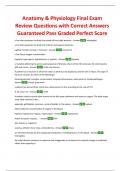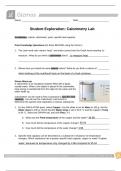Anatomy & Physiology Final Exam
Review Questions with Correct Answers
Guaranteed Pass Graded Perfect Score
a line that separates the body into equal left and right portions - Answer -midsagittal
a line that separates the body into inferior and superior portions.
sagittal, frontal, coronal or transvers - Answer -transverse
a low tissue oxygen concentration.
hypoxia, hypercapnia, hypokalemia, or hypoxic - Answer -hypoxia
a mutation affecting the amino acid sequence of the beta chains of the Hb molecule. the cells become
stiff and curves - Answer -sickle cell anemia
A patient has a fracture in which the radius is bent but not displaced, and the skin is intact, This type of
fracture is known as which of the following?
closed:greenstick, complex: comminuted, compound:transverse, open:spiral or simple:pathologic -
Answer -closed: greenstick
a patient has burned their entire face, what percent is this according to the rule of 9's?
9, 36, 18,or 4.5 - Answer -4.5%
A patient sustains severe blunt trauma to the left upper abdomen and requires surgery. The body organ
most likely involved is the...
appendix, gallbladder, pancreas, urinary bladder or the spleen - Answer -spleen
abnormally low concentration of oxygen in the blood.
hypoxia, hypoxemia, hypoxic, hypercapnia - Answer -hypoxemia
Active transport requires... - Answer -ATP
also known as ringworm.
eczema, athlete's foot, tinea, schleroderma - Answer -tinea
an inherited disorder by the inadequate production of clotting factors in the blood - Answer -
hemopjillia
An initial stimulus produces a response that exaggerates or enhances the original change in conditions
rather than opposing it.
,reaction formation, positive feedback, negative feedback, or absolute refractory period - Answer -
Positive feedback
atoms or molecules that carry an electric charge.
isotope, ion, element, or an atom - Answer -ion
ATP is formed using.... - Answer -the KREB cycle
Begins when sodium channels regain their normal resting condition and continues until the
transmembrane potential stabilize at resting levels.
relative, absolute, refractory period, or relaxation - Answer -relative
Bileenters the GI tract at the ...
gastroesophogeal sphincter, duodeum, ileocecum, jejunum or the pyloric sphincter - Answer -
duodeum
blood flows from the right ventricle of the heart into the...
inferior vena cava, left ventricle, pulmonary arteries, pulmonary veins or the right atrium -
Answer -pulmonary arteries
Bond created by the electrical attraction between anions and cations.
chemical, ionic, covalent, or isotope - Answer -ionic
bond that share electrons.
chemical, ionic, covalent, or isotope - Answer -covalent
bone infection is.
osteopenia, osteoporosis, osteoitis, or osteomyelitis - Answer -osteomyelitis
bones that become overly dense.
osteogenesis imperfecta, osteoporosis, or osteopetrosis - Answer -osteopetrosis
bony enlargements of the middle joint of the finger?
herberden's nodes, buchard's nodes, gouty arthritis, osteoporosis - Answer -buchard's nodes
bony enlargemts of the joins closest to the fingertip.
herberden's nodes, bouchard's nodes, osteoarthritis or gout - Answer -herberden's nodes
Brain wave when the person is in intense concentration?
aplha, beta, theta, or delta - Answer -beta
Brain waves occur in deep sleep and in some pathological conditions.
, beta, alpha, theta or delta - Answer -delta
Brain waves seen in children and in frustrated adults?
beta, alpha, theta, or delta - Answer -theta
broad category of body build and physique - Answer -somatotype
cancer in the bones/
osteopenia, osteoporosis, osteosarcoma, or bone cancer - Answer -osteosarcoma
Cancer that is almost totally restricted to sun exposed to the skin.
sarcoma, squamous cell carcinoma, basal cell carcinoma, malignant melanoma - Answer -
squamous cell carcinoma
Cancer that is extremely dangerous. Melanocytes grow and metastisize rapidly into the lymphatic
system.
sarcoma, squamous cell carcinoma, basal cell carcinoma, or malignant melanoma - Answer -
malignant melanoma
Cancer that originates in the stratum basale.
sarcoma, squamous cell carcinoma, basal cell carcinoma, or malignant melanoma - Answer -basal
cell carcinoma
carries motor commands to the spinal cord.
ascending tracts or descending tracts - Answer -descending tracts
carries sensory information to the brain.
ascending tracts or descending tracts - Answer -ascending tracts
Characterized by hardening and contraction of the skin.
eczema, schleroderma, psoriasis, or tinea - Answer -scleroderma
condition caused by a vitamon d deficiency.
rickets, hypoxemia, hypokalemia, hypoxic - Answer -rickets
cranial nerve I - Answer -olfactory
cranial nerve II - Answer -optic
cranial nerve III - Answer -oculomotor
cranial nerve IV - Answer -trochlear
cranial nerve IX - Answer -glossopharangeal






